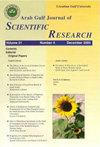Effect of substitution of wheat flour with chickpea flour on their physico-chemical characteristics
Q4 Business, Management and Accounting
引用次数: 0
Abstract
PurposeThe major objective of this research work was to evaluate various physico-chemical characteristics, such as, chemical composition, antioxidant capacity, objective color and texture profile analysis (TPA) of the wheat flour/chickpea flour (CF) blends, so that nutritious baked products could be consumed by the type-2 diabetic persons.Design/methodology/approachWholegrain wheat flour (WGF) and white wheat flour (WWF) were substituted with CF at 0 to 40% levels. These wheat flour/CF blends were analyzed for proximate composition, the prepared dough and baked breads were tested for objective color, antioxidant capacity as trolox equivalent antioxidant capacity (TEAC), malondialdehyde (MDA) and total phenolic content (TPC) and TPA.FindingsWGF had the highest TEAC (117.42 mM/100g) value, followed by WWF (73.98 mM/100g) and CF (60.67 mM/100g). TEAC, MDA and TPC values varied significantly among all the three flour samples.Research limitations/implicationsInclusion of whole chickpea (without dehulling) flour in such type of blends would be another interesting investigation during the future research studies.Practical implicationsThese research findings have a great potential for the production of these baked products for human consumption on an industrial scale.Social implicationsProduction of breads using wheat flour and CF blends would benefits the consumers.Originality/valueProduction of Arabic and pan breads using wheat flour and CF blends would, therefore, combine the benefits of both the needed proteins of plant origin and the health-promoting bioactive compounds, in a most sustainable way for the consumers.鹰嘴豆粉替代小麦粉对其理化特性的影响
目的对小麦粉/鹰嘴豆粉(CF)混合物的理化特性、化学成分、抗氧化能力、客观颜色和质构分析(TPA)等进行评价,为2型糖尿病患者提供营养烘焙产品。设计/方法学/方法:用CF代替全谷小麦粉(WGF)和白小麦粉(WWF),用量为0 ~ 40%。对这些小麦粉/CF共混物进行了近似成分分析,并对制备的面团和烘烤后的面包进行了客观颜色、抗氧化能力(trolox当量抗氧化能力(TEAC))、丙二醛(MDA)、总酚含量(TPC)和TPA的测试。结果swgf的TEAC值最高(117.42 mM/100g),其次是WWF (73.98 mM/100g)和CF (60.67 mM/100g)。三种面粉样品的TEAC、MDA和TPC值差异显著。在未来的研究中,将整个鹰嘴豆(不去皮)面粉纳入这类混合物将是另一个有趣的研究。实际意义这些研究结果对于在工业规模上生产这些供人类消费的烘焙产品具有很大的潜力。社会影响使用小麦粉和CF混合物生产面包将使消费者受益。独创性/价值因此,使用小麦粉和CF混合物生产阿拉伯面包和平底面包将以最可持续的方式为消费者结合所需的植物来源蛋白质和促进健康的生物活性化合物的好处。
本文章由计算机程序翻译,如有差异,请以英文原文为准。
求助全文
约1分钟内获得全文
求助全文
来源期刊

Arab Gulf Journal of Scientific Research
综合性期刊-综合性期刊
CiteScore
1.00
自引率
0.00%
发文量
0
审稿时长
>12 weeks
期刊介绍:
Information not localized
 求助内容:
求助内容: 应助结果提醒方式:
应助结果提醒方式:


